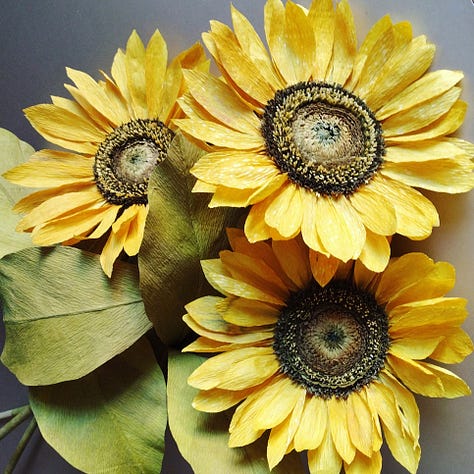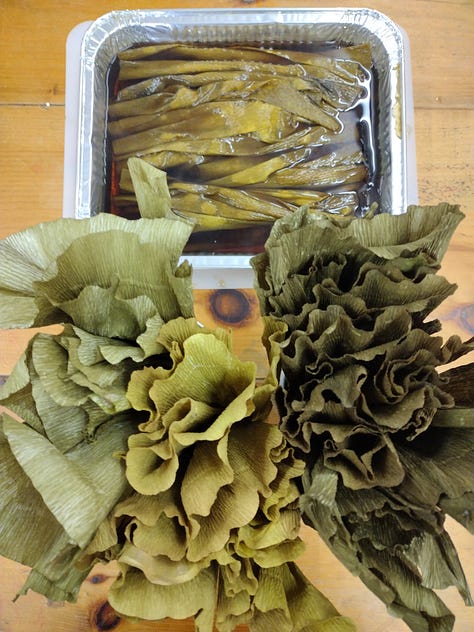Dear fellow flower friend,
How has your week been? I hope you have achieved what you set out to do and that you have enjoyed good health and happiness since I last wrote. Today, I walked to the pond, collected fallen dog rose and bramble petals, and collected my exhibition pieces from World Museum Liverpool.
Back in the studio, I did a quick scan of the beautiful, heart shaped rose petals. Although I guess it has to be the other way round - the rose, a symbol of love, lends the shape of its petal to a stylised heart. So when I instruct students to cut ‘heart shaped petals’ for their wild roses, the symbolism comes full circle. Also shown, Guelder Rose which grows by the pond, a gorgeous frothy white flowering tree. A short week ago the flowers were fresh and full - I’m planning to make a paper version to show you. That will keep me busy next week!
How about you, have you been out and about at all? Where did you go? Have you spent any time in nature?
I love being out by the pond, amongst the trees, surrounded by all those different shades of green. The phrase “spending time in nature” confuses me, implying as it does that we can be either in or out of nature. If you spend time “in nature” then surely, if you are not “in nature” you are outside of it. But… we are nature. So how can we be “out” of nature? Nature is in us, around us, flowing through us. All the time. Plenty of studies demonstrate the benefits to both physical and mental health of “spending time in nature”. In 2022 a fascinating study looked at how a connection to nature influences the relationship between “being in nature” and mental health. It seems intuitive that experiencing a connection to nature - feeling a deep emotional bond to the natural world, a being part of it - would deepen the experience of being “in nature”. And it’s backed up by science: researchers found that nature connection (NC) amplified the positive benefits not only of being “in nature” but being in general: Having a higher-than-average NC is associated with a 7% increase in feelings of worthwhileness, a 6.4% increase in life satisfaction, and a 2.5% decrease in depression risk. (Source H. Liu)
One conclusion - a connection to nature contributes to more positive life choices. It makes sense - if you care, if you feel it, you are more likely to choose to walk than to drive. It may be over simplified but…. Just because you could, doesn’t mean you should.
This brings me back to my original subject: Nature’s Palette, and my exhibition pieces. It was a happy/sad experience, collecting them today. I am not ready to let the project go! In January I set myself the goal of creating the national flowers of all the Eurovision countries* (and they are not all in Europe!) using paper coloured with natural dyes and stains. I try to use easily accessible materials, so I’ve used a lot of onion skin, and when I find a dye stuff I like (that’s you, Madder) I really work to achieve as many shades as I can. So, henceforth the project becomes “Nature’s Palette” - it’s alive again and I feel a glorious creative anticipation! Inspired by British hedgerows (and The Flower Fairies of the Wayside), I’m now working to generate as many natural greens as I can.



Reading about green in Kassia St Clair’s wonderful book ‘The Secret Lives Of Colour’ set me on this path. Green is a notoriously difficult colour - historically the colour was hard to make, very unstable and faded to blue, and when Scheele’s Green was launched in 1775 it contained toxic levels of arsenic - people were literally being killed by their wallpapers! Even now, green is a troublesome colour - green is definitely not “green”. Did you know green papers and plastics cannot be safely recycled because they could contaminate everything else? (source). I even see it in the coloured crepe paper I use - green is ridiculously volatile, fades quickly and reacts to PVA, turning blue or orange. As for where the colour comes from, manufacturers are notoriously secretive about how they make their colours. When I make my plants and flowers, I like to know where the colour comes from. Making art with the potential to harm the nature it celebrates? Doesn’t feel right. More onion skin for me!
If this resonates with you, why not subscribe to my letter? I’m feeling my way forward and working out what I’m offering, for now everything is free, as time progresses I hope to bring more creative inspiration and access to tutorials into it. let me know in the comments what you’d like to see more.
As always IMPORTANT DIARY DATES are in the postscript. If you’re on the Wirral and doing the tour, I hope you can make it to my open studio in Hoylake this weekend!
With much love and until next time, Ling x
*if you missed it, Eurovision in 2023 took place in Liverpool, which for me, is “just over the water” so it all made sense in January!
PS Would you like to learn the art of making paper flowers?
Upcoming workshops at Studio 3, Hoylake include Paper Peonies on 20th June; English Garden Rose on June 22nd; Perfect Poppies on 27th June; Natural Dye for Paper on 30th June; Blue Flag Iris on 4th July; Paper Cornflower on 6th July. Until the end of June you can enjoy up to 15% off workshop bookings!
I’m at Toolerstone House in Tarporley on 11th and 12th July - limited spaces remaining on my Paper Wildflower Posy and Painterly Peony Workshops, please book direct with Toolerstone. They both promise to be fabulous days - a great venue, beautiful gardens and delicious lunch - see you there!
Don’t forget to visit The Paper Meadow which is now at The Visitors Centre, Wirral Country Park, Thurstaston until the end of June. It looks marvellous, I’m so proud of all the children who took part in creating this installation.






